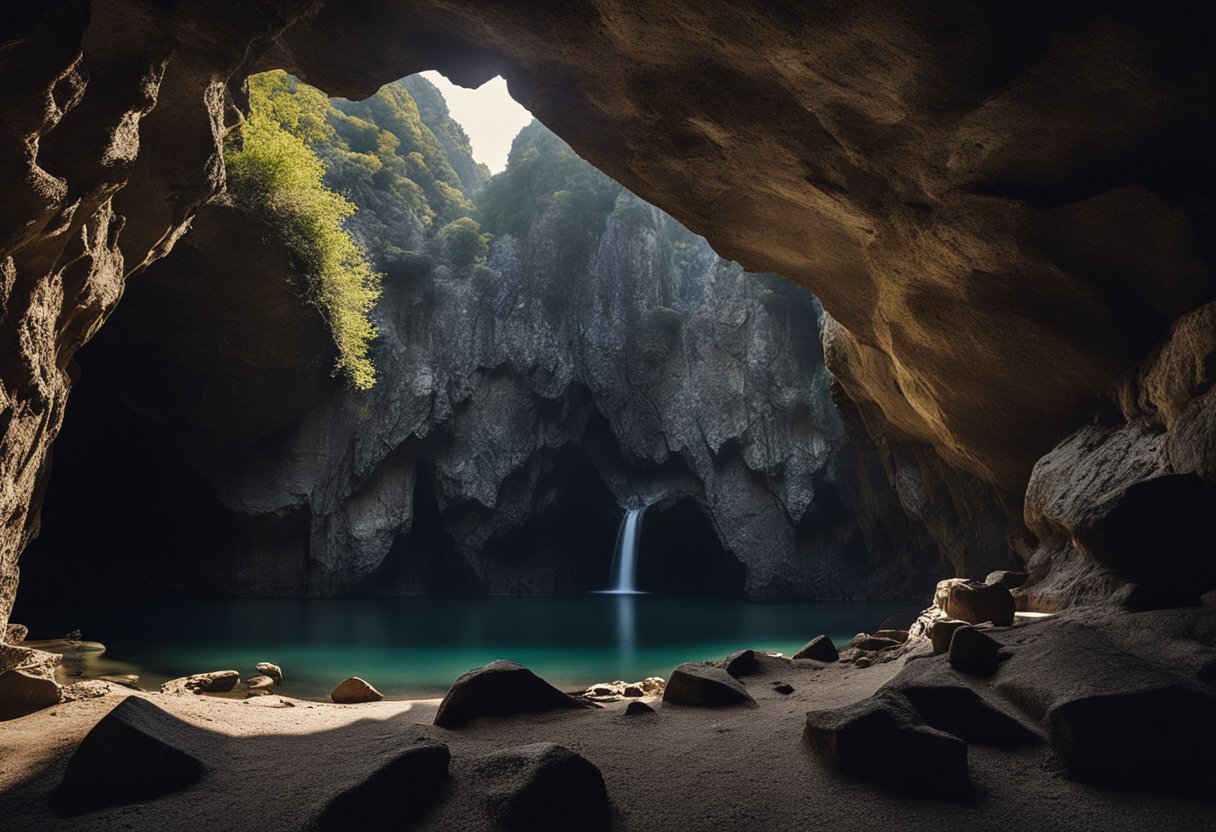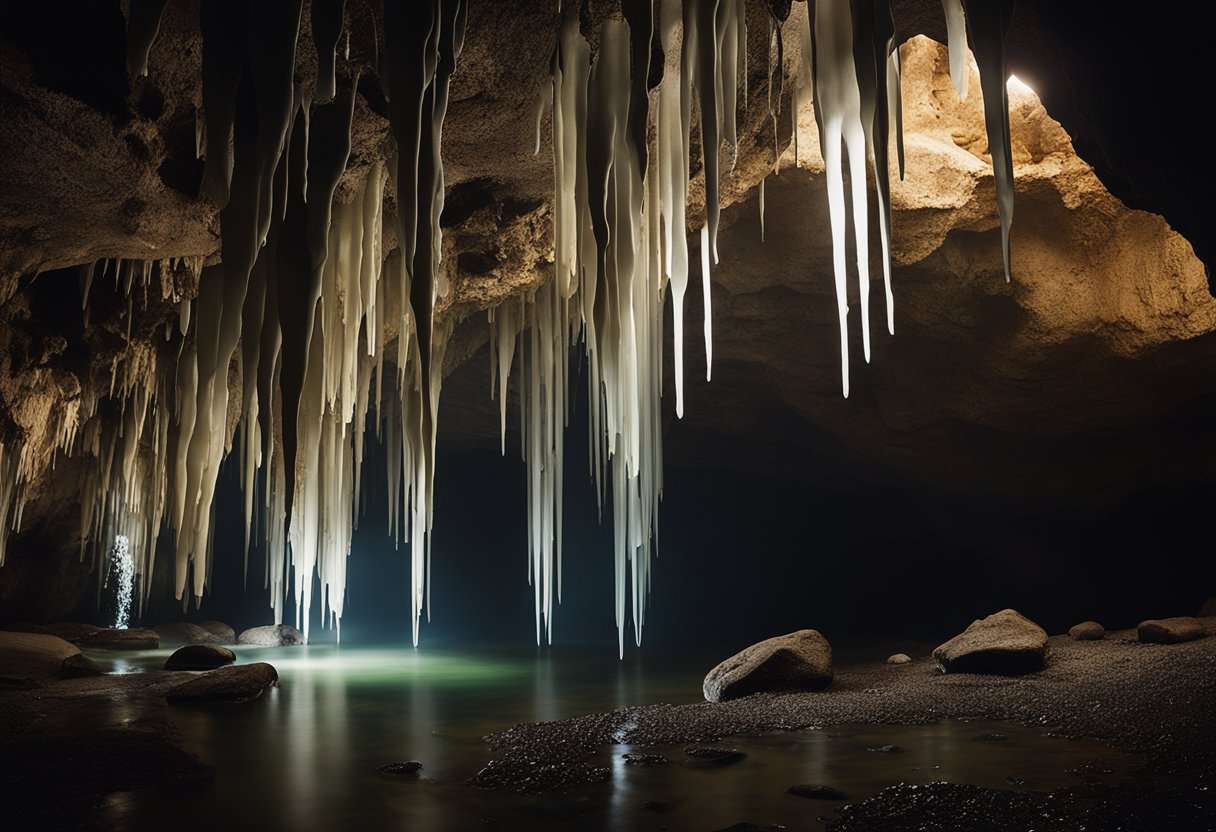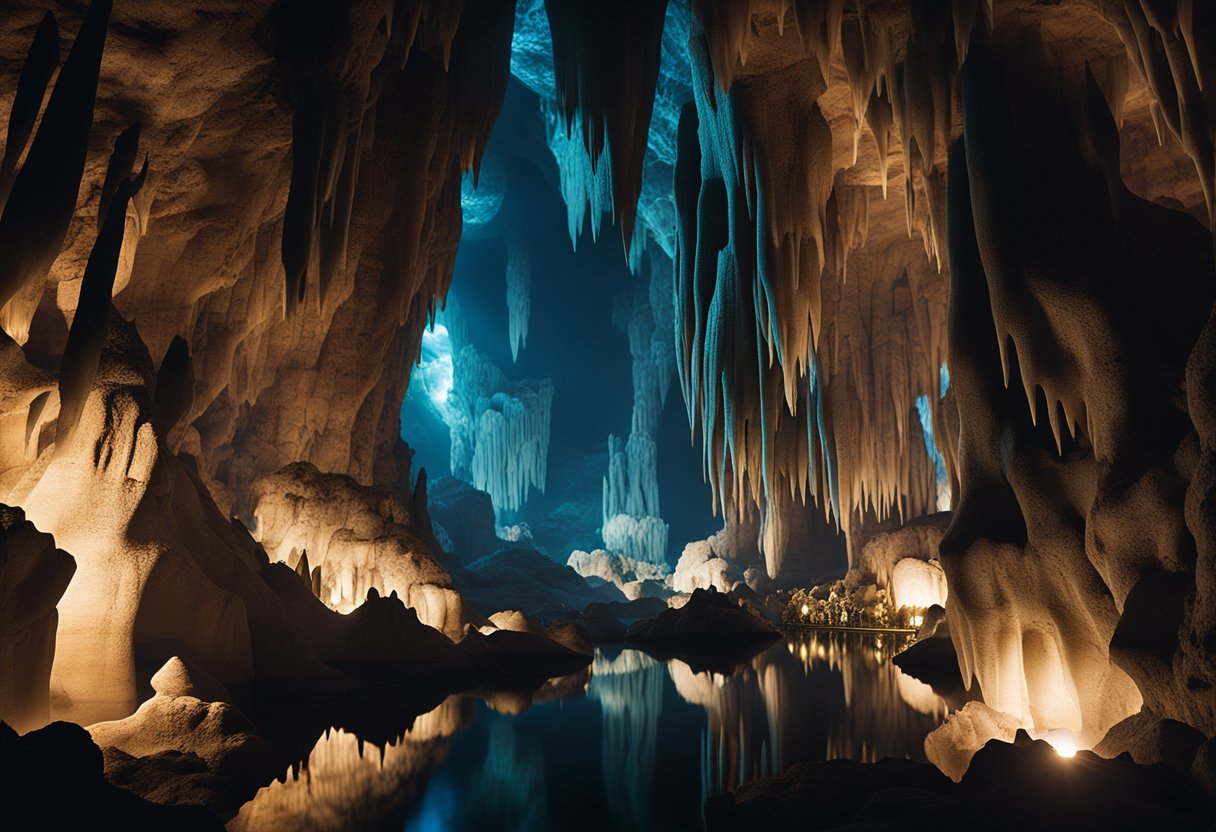The Art of Darkness: A Journey into the World’s Enigmatic Cave Systems

Updated On: April 15, 2024 by Panseih Gharib
Venturing into the subterranean cave systems offers an experience like no other – a journey through the Earth’s most enigmatic natural galleries, where history, geology and myths intertwine. We discover the silent stories etched in stone by the patient work of water and time, unveiling a world of darkness that has captivated humanity since time immemorial. Exploring these mysterious caves allows us to step into a realm of perpetual twilight, where each formation holds a story and each chamber echoes the ancient past.

The world’s caves are rich with tales of humanity, science, and the compelling force of nature. They provide a window into the geological processes that have shaped our planet over millennia and the biodiversity that has adapted to life in complete darkness. Over time, human interaction with these enigmatic spaces has woven a tapestry of legend and folklore, with each geologic wonder being the key to unlocking another piece of our planet’s vast history.
The Geology of Caves
Before we explore the wondrous subterranean landscapes, it’s essential to understand the geological processes that give rise to caves. The Earth’s dynamic systems carve these natural underground chambers, often through the dissolution of limestone by acidic water.
Limestone and Calcite Formations
Caves predominantly form in limestone, a sedimentary rock consisting largely of the mineral calcite. Over geological time scales, the deposition of marine organisms’ skeletal fractions creates vast limestone beds. It is in these beds that many of the world’s caves are found. Speleothems, the intricate features within caves such as stalactites and stalagmites, are also made of calcite. These formations arise from mineral-rich water dripping and flowing through the cave’s interior, precipitating calcite as the water evaporates.
Acidic Reactions and Cave Formation
The process of cave formation often begins with acidic reactions, where rainwater, combined with carbon dioxide from the atmosphere, forms a weak carbonic acid solution. As this acidic water seeps through soil and rock, it dissolves the limestone along fractures and bedding planes. Over time, these small openings expand, forming underground voids and caverns. The concentrations of acid in the water and the presence of other acids from soil or vegetation can influence the rate at which the limestone is dissolved, thereby affecting the cave’s development.
Through these processes, the seemingly solid bedrock is sculpted into a hidden landscape, complete with its own unique geological features and formations. The study of these cave systems not only reveals much about Earth’s geological past but also offers a fascinating glimpse into an environment that few have the chance to witness first-hand.
Caves Through the Ages
Within the depths of the Earth lie gateways to the past, where the walls whisper of ancient times and lost civilisations. We explore these subterranean galleries, tracing the marks left behind by our ancestors.
Ancient Art and Archaeological Finds
Stepping into the gloom of primeval caves, we are confronted by the canvas of prehistory. The Chauvet Cave in France serves as a preeminent example, its walls adorned with some of the earliest known pieces of ancient art. These paintings not only exhibit artistic merit but also offer a glimpse into the minds of those who lived over 30,000 years ago. Encounters with fossils and artefacts within these caves allow us to reconstruct a narrative of survival, artistry, and innovation that defines archaeology.
Archaeological excavations across the globe reveal that caves have served as archives of rock art. From Patagonia to the far reaches of Indonesia, our forebears have left behind a rich legacy etched into stone – a testament to their existence, beliefs, and ingenuity.
Historical Significance of Caves In Human Culture
Caves have long held a place of mystique and reverence within human culture. Throughout history, they have been sanctuaries for sacred rites, habitation, and even burial sites. Their seemingly immutable presence offers us a unique, unaltered look at past cultures.
In our journey to understand human history, caves are more than geological formations; they are cultural landmarks that connect us with the bygone eras. They teach us about the resourcefulness of ancient communities and cultures that once viewed these spaces as a confluence of the natural world and the spiritual realm.
Biodiversity in the Darkness

In the obscure recesses of the world’s caves, biodiversity thrives in ways unlike anywhere else on Earth. We’ll explore the unique life forms that have adapted to these dark environments and the complex ecosystems that they support.
Adaptation of Cave-Dwelling Creatures
Cave-dwelling creatures, or troglobites, exhibit remarkable adaptations for survival in constant darkness. The absence of light has led to the evolution of enhanced sensory organs, such as the elongated antennae and non-functional eyes seen in many cave fish and crustaceans. Speleothems, the stalactites and stalagmites dotting caves, are not mere decorations but also contribute to the unique habitats that host these specialised creatures.
Ecosystems Hidden Within the Earth
Beneath the surface, caves harbour diverse ecosystems, disconnected from the sun’s energy. These systems instead rely on chemosynthesis, a process where bacteria convert substances such as hydrogen sulphide into food. This forms the base of the food chain, supporting a variety of creatures including blind fish, bats, and invertebrates. These organisms are part of a delicate balance, recycling nutrients and sustaining the subterranean biodiversity.
Caves as Natural Wonders
As we explore the remarkable caverns below the Earth’s surface, we uncover a world where natural features form mesmerising wonders. From sprawling underground chambers to delicate mineral formations, the beauty of these sites is undeniable.
Remarkable Caves Around the World
Caves are the Earth’s hidden treasures, with some like the Carlsbad Caverns in New Mexico, boasting expansive chambers such as the Big Room. This cavernous space is one of the largest underground chambers known, illustrating the grandeur that these natural wonders possess. Each cave around the world showcases a unique tapestry of geological history.
- Carlsbad Caverns: Known for the Big Room, a chamber so vast it’s almost incomprehensible.
- Waitomo Glowworm Caves: Where bioluminescent insects create a star-like spectacle against the darkness.
Venturing into these spaces, one cannot help but be awed by the sheer scale and beauty of these subterranean landscapes.
Showcasing Unique Cave Features
Delving deeper, caves reveal an array of intricate features. Stalactites and stalagmites rise and fall in stony silence, the product of mineral-rich water dripping over millennia. In some caves, one might encounter ‘cave popcorn,’ a peculiar yet fascinating formation that adds texture to the subterranean scenery.
- Stalactites: Icicle-like structures hanging from cave ceilings.
- Stalagmites: They grow from the ground up, often meeting stalactites to form columns.
- Cave Popcorn: Knobby clusters that add a rough texture to cave interiors.
Our appreciation for these underground marvels grows with each unique feature we discover, from towering stone columns to the minute details of formations like cave popcorn.
Water’s Role in Cave Systems
Cave systems are dynamic environments where water plays a pivotal role in their formation and ongoing evolution. From shaping the intricate passageways to supporting unique ecosystems, water is the lifeblood of these subterranean landscapes.
The Impact of Water on Cave Development
Water’s influence on cave development is profound. It begins with rain, seeping into the ground and gradually dissolving soluble rock, such as limestone, through a process called chemical weathering. This results in a slow but steady enlargement of crevices, eventually forming vast networks of hollowed-out spaces beneath the Earth’s surface. These spaces become the caves we explore. Water continuously shapes these environments, carving out intricate formations like stalactites and stalagmites that adorn cave interiors, creating a natural art gallery sculpted over millennia.
Subterranean Rivers and Cave Diving
Subterranean rivers are the hidden arteries within cave systems, often playing a crucial part in cave diving expeditions. Cave divers navigate these aqueous highways to reveal secrets of the Earth’s interior and to understand the hydrology of cave networks. Cave diving is not just an adventurous pursuit; it serves scientific purposes. By probing the depths, divers assist in mapping these hidden water routes and contribute to research on the unique life forms adapted to these dark aquatic environments. Our understanding of subterranean biodiversity and the geologic history that these waters have carved is intricately tied to the bravery and skill of cave divers.
Human Interaction with Caves
Caves have long captivated human imagination, serving as sites for exploration, cultural expression, and tourism.
The Attraction of Cave Exploration
We, as cavers, are drawn to the subterranean world by an innate curiosity and the allure of the unknown. The pursuit to uncover new passages and geological formations thrusts us into a unique blend of adventure and scientific research. Cave exploration often entails navigating through narrow passageways with torches in hand, revealing the hidden beauty of these dark sanctuaries. The intrigue of this pursuit is amplified by the risk involved, as unpredictable cave environments demand both physical endurance and mental resilience.
Caves in Modern Culture and Tourism
In contemporary society, caves hold a prominent place as both natural wonders and tourist attractions. We see a diverse array of caves transformed into concert halls, art galleries, and even hotels, integrating the ancient allure of caves into modern culture. For tourists, the opportunity to witness the majestic formations and historical cave art first-hand makes for an unforgettable experience. Our role in responsibly promoting cave tourism is crucial, ensuring that these geological marvels are preserved for future generations to explore and appreciate.
The Science of Speleology
In exploring the world’s most enigmatic caves, we actively engage with the science of speleology, a field dedicated to the comprehensive study of caves, their environments, and their geological formations. It is an interdisciplinary endeavour involving rigorous methods and analyses to unearth the secrets held within the subterranean world.
Studying the Subterranean World
Embarking on the scientific exploration of caves requires a thorough understanding of various environmental factors and processes. Speleologists combine a variety of techniques from numerous disciplines to map cave systems, analyse rock formations, and study cave fauna. They observe and catalogue cave structures, or speleothems, looking for clues about past climatic conditions and the ways in which these spaces have evolved over time. Technologies such as 3D scanning and geographical information systems (GIS) have revolutionised how we document and interpret cave layouts and features.
The Contributions of Geologists
Geologists are fundamental to speleology, as their expertise in rock formation and mineral deposits provides insights into the history and development of natural underground chambers. They examine the geochemistry of caves to understand the processes that result in the magnificent arrays of stalactites and stalagmites. By conducting detailed analysis, geologists can also assess the potential for natural resources within caves and contribute to the conservation of these fragile ecosystems. Our understanding of cave geology evolves with each expedition, adding layers of knowledge to the fascinating narrative of Earth’s history.
Conservation of Cave Environments

Cave environments are unique ecosystems that require tailored conservation efforts to maintain their integrity and protect the myriad of life forms they harbour. It’s our responsibility to approach these fragile habitats with a strategy that ensures their preservation for future generations.
Maintaining Cave Integrity
The stability of cave ecosystems is reliant upon the maintenance of their natural state. Human activities, such as caving and tourism, pose potential threats to these underground environments. We must enforce strict access control and visitor education to minimise human impact. By using conservation measures such as designated pathways, we can prevent the degradation of delicate cave formations and the inadvertent spread of pollutants.
Protecting Cave Wildlife
Cave wildlife, from diverse microorganisms to specialised invertebrates, plays a crucial role in the ecosystem balance. These animals are often endemic and highly sensitive to changes in their environment. We implement protective legislations and conduct careful monitoring of cave species to ensure their survival. Awareness campaigns aimed at highlighting the importance of cave species in indicating the ecological health of the area are also vital—as noted in the discussion on NAU cave ecologist’s research, which underscores the link between sensitive cave species and human well-being.
Caves in Popular Regions

Cave systems, whether for their ancient formations or historical art, strike a chord with explorers and anthropologists alike. We often find these natural wonders in regions teeming with tourists, eager to witness the majesty of the underground.
European Caves and Their Heritage
Europe’s caves are a testament to prehistoric life, housing some of the world’s most renowned examples of early human creativity. In northern Spain, the Atxurra Cave is known for its carvings of horses, bison, deer, and mountain goats dating back some 12,500 years. Furthermore, France’s Chauvet Cave boasts spectacular lion and rhino depictions that are considered to be roughly 30,000 years old, making it a pivotal site for understanding the dawn of art.
North American Cave Systems
In North America, we can find a variety of significant cave systems ranging from the intricate formations in New Mexico’s Carlsbad Caverns to the prehistoric rock art in Utah’s Canyonlands. Alabama is home to more than 4,400 caves, including the notable Russell Cave, which acts as an important archaeological site. Over in California, caves like the Lava Beds National Monument offer a look into both geologic and historical wonders, from volcanic landscapes to Native American petroglyphs.
Cave Formations and Their Significance

Cave formations, the stunning structures that adorn cave interiors, result from geological processes that unfold over millennia. They not only contribute to the beauty of subterranean landscapes but also provide valuable insights into the history of our planet’s development.
The Phenomenon of Cave Popcorn
Cave popcorn, or coralloids, is a speleothem that adorns cave walls, ceilings, and formations with small, knobby clusters that resemble popcorn. These formations emerge as mineral-laden water drips and evaporates, leaving behind deposits, typically of calcite. Over millions of years, these textured accretions flourish in areas of airflow within caves, pointing to historical shifts in a cave’s climate and water levels.
Gypsum and Sulfuric Acid in Caves
In the depths of many caves flows a narrative of intense geochemical interactions. The presence of gypsum—a mineral often found crystallized as selenite, satin spar, or alabaster—speaks volumes about the subterranean environment. When sulfuric acid percolates through limestone, it reacts to create gypsum, a process that can signal the presence of hydrocarbons or other volatiles deep in the Earth’s crust. This intricate dance between chemistry and geology sculpts cavernous spaces and intricate speleothems within cave walls, narrating the Earth’s underground history.
Cave Mysteries and Legends
In the shadowy recesses of the world’s caves lie ancient myths and unsolved mysteries that continue to captivate our imaginations. As we delve into these subterranean realms, we uncover stories woven into the fabric of local cultures and chronicles of explorations that have puzzled historians for centuries.
Mythology and Tales of the Underground
The underground has long been a source of awe and mystery, inspiring countless myths and legends. For instance, caves are often depicted as gateways to the underworld in mythology, serving as portals where heroes confront their fears or gods interact with mortals. The Greeks spoke of the entrance to Hades in their tales, while many indigenous cultures revered caves as sacred places where the earth and the spiritual worlds meet.
In the dense jungles of Central and South America, caves were often considered the abode of gods and spirits. The Maya believed that caves, or Xibalba, represented an entrance to the underworld, and they were therefore treated with a mixture of reverence and fear.
Unsolved Mysteries in Caving History
The history of caving is replete with unsolved mysteries that have eluded explanation. Explorers have occasionally stumbled upon bizarre artefacts and unexplained phenomena that challenge our understanding of history. For example, the discovery of Paleolithic art in European caves suggests advanced levels of cognition in early humans. The contemporary interpretation of these artworks can be studied in detail, offering hints towards the mysterious symbolic language of our ancestors.
Findings such as these, nestled deep within the mysterious cavities of the earth, defy simple analysis and continue to bewilder experts. Their existence raises questions about the extent of prehistoric human exploration and the purposes these once dark and inaccessible places served to our forebears.
Frequently Asked Questions
In this section, we address some of the most common inquiries about the world’s most enigmatic caves, providing clarity on their characteristics, spiritual significance, and the intriguing stories that shroud them in mystery.
What are the defining characteristics of the world’s most enigmatic caves?
The world’s most enigmatic caves are often characterised by their extensive and complex systems of passageways, remarkable geological formations, ancient rock art, and ecosystems thriving in isolation from the outer world.
Which caves around the world are considered the most sacred?
Caves like the Batu Caves in Malaysia and the Lascaux Caves in France are revered for their religious significance and prehistoric paintings, drawing both pilgrims and historians alike due to their cultural and historical importance.
How does one typically explore spiritual caves?
Exploring spiritual caves usually involves guided tours that respect the sanctity of the site, often requiring careful navigation and sometimes participation in traditional rituals or practices that have been observed for centuries.
What factors contribute to a cave being classified as mysterious?
A cave is often classified as mysterious due to its unexplored regions, association with legends or supernatural occurrences, and the presence of unusual geological features that challenge our understanding of natural processes.
In what ways are the stories of Mammoth Cave significant in the context of global cave explorations?
The stories of Mammoth Cave in Kentucky highlight its significance as the world’s longest cave system, featuring rich biodiversity and a labyrinth of passages filled with intriguing tales of discovery and historic expeditions.
What are some of the most powerful experiences reported by explorers in mysterious caves?
Explorers in mysterious caves often report profound experiences of awe upon witnessing otherworldly formations, encounters with rare fauna, and the overwhelming silence that reigns in the subterranean depths, connecting them deeply to the planet’s ancient past.






